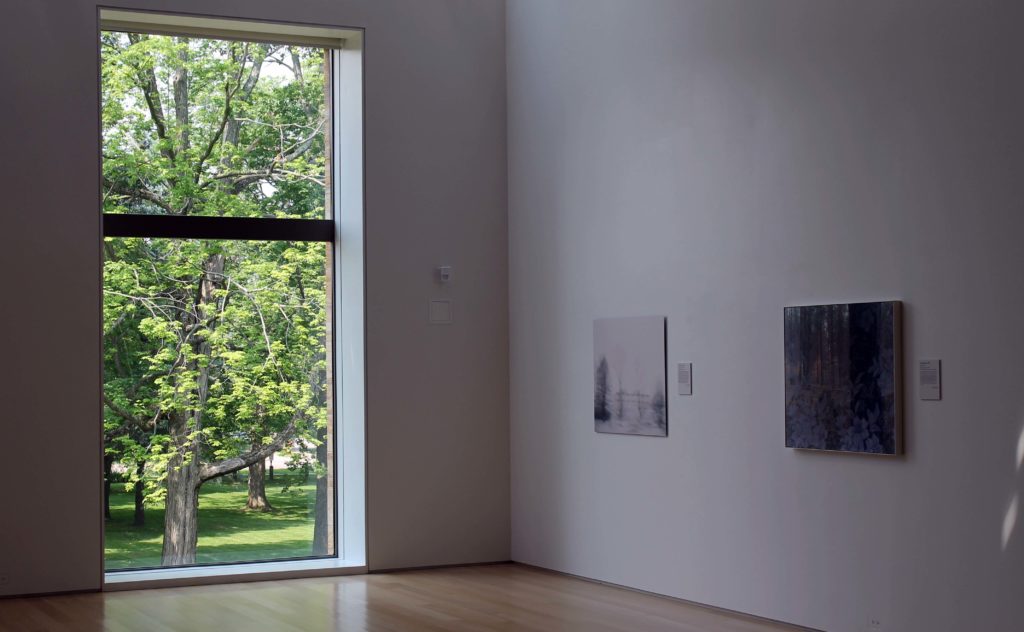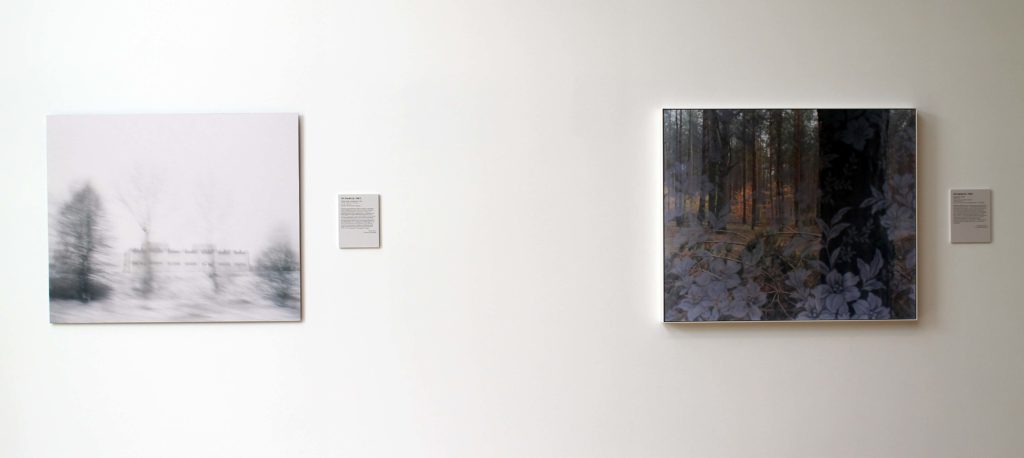
that the panels featuring trees are hung next to the grand
window framing the trees of the Kenyon College Campus?
Yesterday was serendipitous in more than one way (see “A Gift for a Fellow“). After the Kenyon Writers Workshop ended, I took myself on an Artist’s Date and visited the Gund Gallery at Kenyon College. What happenstance that I should walk into an exhibit by artist and photographer Ori Gersht that examines one of the central topics of my writing – the question of whether a place can harbor a memory. In fact, the essay I read last Sunday night was about my obsession with my grandparents’ former house in the Czech Republic.

by Ori Gersht, Gund Gallery
The exhibit’s very first panel, Drape #03, blew me away: The image of a pine forest is seen through the shroud of a floral gauzy curtain. Only it isn’t any pine forest, it’s the site of the Nazi extermination camp Sobibor, where the Germans planted pines after they had destroyed the camp to mask the mass grave of a quarter million Jews. So, is this just a forest? Are these just trees? As Ori Gersht says in his illuminating artist talk, once you know the history of a place, you never look at it the same again.

The following, written on the label next to Liquidation: Drawing Past, really resonated with me:
In this work from Gersht’s Liquidation series, historical time and lost memory are again evoked through the blurred and somber darkness of forest trees. Over the course of several journeys into rural Galicia, a region in southwest Ukraine from which his family originated, Gersht photographed landscapes that held both the histories of his origin and historical resonance. Speaking on his personal relationship to this work:
When I was looking at the landscape in the Ukraine I was seeing all these houses and trees that were there 60 years before and are living there now with total indifference to the human horrors that took place but somehow bear within them the memory of those events. Our sense of time as human beings is limited to 70 or 80 years but all these landscapes spread over a cosmic or geological perception of time. Some of the trees are hundreds and hundreds of years old, they bear with them the memory of all previous events and at the same time keep a certain silence and are impenetrable.
– An excerpt from an interview with Ori Gersht by Camilla Jackson, Senior Curator at the The Photographers Gallery in London
– Natalie Marsh
Director, Gund Gallery

by Ori Gersht, Gund Gallery
I am usually not one for video installations, but I sat through, totally mesmerized, both of Gersht’s HD dual-projection films: Will You Dance For Me, featuring ballet dancer and concentration camp survivor Yehudit Arnon, and Evaders, about German-Jewish philosopher Walter Benjamin‘s fateful and futile trip across the Pyrenees in 1940.
It is immensely uplifting and validating to find art, work, writing that you connect with, and it is a special gift to discover an artist you didn’t know about who concerns himself with the very same questions you are asking. All of this is amazing enough, but for me to happen upon an Israeli artist who captures in images what I have been trying to capture in words, and to happen upon his work in the bucolic countryside of central Ohio, how likely is that?

Beeindruckende Fotos, beeindruckender kuenstlerischer Ansatz, beeindruckender Kuenstler. Sehr gelungene Mischung aus Geschichte, Vergangenheit und Gegenwart. Sehr wertvoller Beitrag fuer mich. Danke!
Barbara – danke! Ja, fuer mich war das ein ganz besonderer, voellig unerwarteter Gallerie Besuch. Denke immer noch darueber nach, habe mir auch den Artist Talk auf dem Site der Gund Gallery angehoert. Empfehlenswert!
Certainly harrowing images, when you hear the story behind them.
William – that's the thing – the pictures are quite harmless until you know the story.